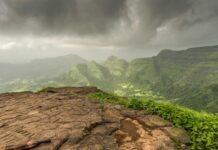 A former princely state, Mandi in the state of Himachal Pradesh is located on the banks of the Beas River. This historic city has retained much of its past glory and elegance. Steeped in the grandeur of its past, Mandi has made a flourishing changeover into an effervescent and bustling city.
A former princely state, Mandi in the state of Himachal Pradesh is located on the banks of the Beas River. This historic city has retained much of its past glory and elegance. Steeped in the grandeur of its past, Mandi has made a flourishing changeover into an effervescent and bustling city.
Famed for its stone temples, this city is popularly called the ‘Varanasi of Hills’. The majestic palaces and finely carved temples speak of the princely elegance of this pictorial town. Elegant mansions of Victorian era add to the charm of this beautiful picnic spot. Mandi is believed to be the place where the great sage ‘Mandav’ had undertaken his penance and legends say that his reparation was so severe that the rocks were turned black due to it.
A swiftly emerging tourist destination, Mandi is an ideal location for shopping. The Tibetan handicrafts and handlooms put for sale are really eye catching. Holidaying in Mandi provides an exclusive picture of a thriving city with numerous striking and blessed places to roam in, hot streams with curative powers and startling trekking grounds.
Apart from the glorious monuments and amazing natural spectacles, Mandi is also renowned for its fairs and festivals. Since most of the temples in this hilly terrain are in the name of Lord Shiva, Mahashivaratri is celebrated here with much pomp and enthusiasm. The most attractive fair here is the Nalwar Mela. The herd of bullocks in colorful makeup steals the show.
The gods have bestowed Mandi with awesome beauty. With the lustrous tea plantations, rambling pine and deodar forests, the rich variety of fauna swathed in the imposing peaks, Mandi is a delightful hill station to be explored.
Chauntra Valley
A small village close to Mandi, the village lies en route to the famous paragliding spot of Bir. Of late, a small Tibetan settlement and a Tibetan University have come up, making this place a budding tourist attraction.
Rewalsar Lake
A great pilgrim centre at an altitude of 1,350 meters, where coexist three different shrines of different religions, Rewalsar Lake at Mandi holds such a miracle. A Hindu temple, a Buddhist monastery and a Sikh gurdwara are situated here in wonderful harmony. This lake, which is famed for its hovering island, has an imposing shoreline of 735 meters.
With great historical value, this place holds numerous legends about its sanctity. Hindus believe that it is closely associated with the Pandavas and others feel that this was the abode of Padmasambhava. Whatever be the truth, this place is frequented by large number of Hindus, Buddhists and Sikhs alike.
Sunken Garden
A verdant green garden with a thriving shopping complex Sunken Garden in Mandi is a spectacle of hill architecture. A pagoda-type structure with a clock tower is the major attraction. Behind this amazing structure there lies the heinous story of the erstwhile Mandi king, who killed his own son in law and buried him in the present day Sunken garden.
A small lake in the earlier times, Sunken Garden was converted into its present form by the last Raja of Mandi, Joginder Sen. This 500 year old garden and its adjoining structures retain their royal ambience even today. All cultural and other activities in and around the city are organized in this garden.
Ardhnareshwar Temple
Lord Shiva in the composite form of half man and half woman is the principal deity of this unique temple. Such temples are very rare in the India and the deity here signifies the beautiful ideology of Ardhnareshwar. Apart from the feeling it generates, this temple exhibits the richness of traditional architecture with elaborate carvings.
It is remarkable to notice that the female is depicted in the left portion of the deity. The myth behind this fabulous shrine might be the principle that women are integral part of men’s life. A unique temple, which displays exceptional architectural elegance, is now a protected monument under the ASI. The holy darshan of this ancient temple evokes great emotion in the minds of devotees.
Bhima Kali Temple
The family deity of the erstwhile Bushahar rulers, Bhima Kali Temple is located on the banks of the Beas River. Dedicated to goddess Bhimakali, this temple presents an architectural marvel. The temple also houses a large museum. Mythology says that this was the place where Lord Krishna fought a terrific war with Banasura, the demon king. The myth further says that the head of the routed king was buried in the earth.
The land was then ruled by the descendants of the Yadava clan and they had constructed here a magnificent temple complex in which Bhima Kali adorns the main sanctum. So many other shrines dedicated to various gods and goddess find their place in this complex. Apart from its serenity and structural elegance, this shrine also commands the stunning scenery of the majestic Shrikhand mountain peak.
Bir Monastery
Between the villages of Bajinath and Mandi is a small settlement of Tibetans. There are many monasteries here which are an epitome of the great Buddhist influence in this region. The most popular among them is the Nyingma monastery, which is known for its interiors and various Thangka paintings which adorn the walls.
Panchvaktra Temple
This small hilly area has more than three hundred temples flanking the River Beas. Almost all the temples display world-class architecture and structural designs that forced the Archaeological department to declare them as protected monuments.
One among these protected monuments, Panchavaktra temple has been adjudged as a national heritage site by the ASI. Panchvaktra Temple is a perfect example of Shikhara style architecture. Dedicated to Lord Shiva, the deity here has five faces, which depict his five characteristics. Placed at the convergence of Suketi and Beas rivers, the serenity of the temple is very appealing.
Triloknath Temple
Among the oldest temples in Mandi, Triloknath Temple is situated at Purani Mandi. Built in AD 1520 by the then queen, Sultan Devi, Trilok Nath temple features excellence in architecture. Dedicated to Lord Shiva, the temple premises are enshrined with numerous images of the destroyer of the universe.
The main deity is seen flanked with his consort Parvati and the Nandi Bull. The sanctum of the temple is adorned by a three-face image of Lord Shiva, which is quite captivating. Besides the main deity, the temple also holds idols of other gods like Sharda and Narada.
Trekking
Nestled in the lap of the highest mountain peaks of the Himalayas, Mandi offers great opportunities for trekking. Its verdant valleys, snowcapped mountains and thick jungles are the perfect spots of a memorable trek.
Trekking in Mandi needs great stamina and courage. Exploring the wilderness of this great Himalayan region gives one a revitalizing feeling. Summer is the best season to go for trekking since it provides a salubrious climate. But professional trekkers often take the dangerous task of trekking in the winter since the mountains and their surroundings show beauty at its peak.
How to Reach
By Air: The Bhuntar Airport is the nearest air base to Mandi, located at a distance of about 59 km from the town. The airport is connected to major Indian cities like Shimla, Delhi, and Mumbai with regular flights. Taxi services are available from the airport to Mandi.
By Train: The Kiratpur Railway Station is the nearest rail head located at a distance of about 125 km from Mandi. This station is well connected with all major cities of India via Chandigarh. Taxi services are available.
By Road: State owned buses, which connect Mandi to its neighboring cities, can be availed by tourists to reach the destination. Private deluxe bus services are also available.






